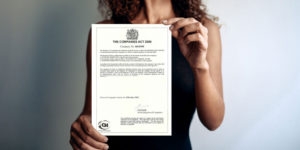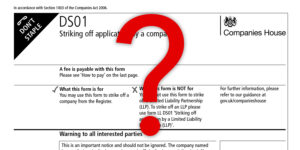The process you must follow to dissolve a company is relatively straightforward and inexpensive. However, to close a company this way and get it struck off the Companies House register, the business must be solvent (able to pay its bills). Additional criteria also apply, and you need to take certain steps to close down the business properly.
We discuss all of the requirements below and explain the process in detail. By the end of the post, you should have a clear understanding of how to dissolve a UK-registered company.
Dissolving a UK company
Commonly referred to as company dissolution or strike-off, dissolving a company is an administrative process that results in the permanent closure of a solvent company. It’s a cheap and simple procedure that you can carry out with approval from the board of directors.
There are several reasons why you may need to dissolve a company. Perhaps the business is no longer viable, or you’ve decided to move on to something else or retire altogether. It could even be the case that you set up the company as dormant simply to protect a business name and it’s no longer required.
Whatever the reason, the company must satisfy the following criteria to be eligible for voluntary dissolution, as set out in section 1004 and section 1005 of the Companies Act 2006:
- has not changed its name in the last three months
- has not traded, carried on any other business activity, or sold off any of its assets in the last three months
- is not threatened with liquidation
- has no ongoing payment agreements in place with its creditors – for example, a Company Voluntary Arrangement (CVA)
If the company satisfies all eligibility criteria, the directors can approve the action by passing a board resolution. You can do this at a board meeting or by written board resolution.
If you’re the company’s sole director, you can pass the resolution on your own. Where there are two directors, both must agree. And for companies with multiple directors, a simple majority (i.e. more than 50%) must approve the resolution.
Once the decision has been made, you must close down the business properly before sending a formal striking-off application to Companies House.
Closing down your company before dissolution
The dissolution process itself is pretty straightforward. However, closing the business in preparation for striking off can take some time, depending on your company’s circumstances. The preliminary steps you need to take are as follows:
1. Stop trading
You must cease trading at least three months before applying to strike off the company. If you have outstanding orders to complete, you’ll need to deal with these as soon as possible and collect all payments due from clients.
Should any trading or business activity occur in the three months before submitting your application, it may be unlawful and Companies House could reject your dissolution request.
2. Notify all interested parties
You must announce your plan to strike off the company to anyone likely to be affected by its closure, including (where applicable):
- members (i.e. shareholders or guarantors)
- creditors – including banks, lenders, and loan guarantors
- employees and workers
- customers and clients
- suppliers and service providers
- landlords or tenants
- local authorities
- managers or trustees of your employee pension fund
- HMRC and the Department for Work and Pensions (DWP)
Notifying those who may have an interest in the company’s affairs is a legal requirement. Doing so ensures they have an opportunity to object to the company being struck off before you begin the application process.
3. Deal with business assets
It’s important to deal with all business assets before dissolving your company. Otherwise, any assets still held in the company name at the time of dissolution will become ‘bona vacantia’ (ownerless property) and automatically pass to the Crown.
Business assets include:
- land and buildings
- equipment and machinery
- stock and materials
- intellectual property
- shares held in other companies
- cash
- credit balances in business bank accounts
- any payments due from HMRC or elsewhere
In most circumstances, you can apportion the assets (or the proceeds from their sale) between the company’s members. That being said, you may need to use some of these funds to pay the company’s final bills and any outstanding debts.
If you take any of the assets or sale proceeds for yourself, you may be liable to pay Capital Gains Tax on the amount you receive. However, if the proceeds or value of the assets amount to more than £25,000, HMRC will treat the distribution as income, which will be liable to Income Tax instead.
In either case, you should check whether or not you are eligible for Business Asset Disposal Relief (previously known as Entrepreneurs’ Relief). This could reduce the amount of tax you need to pay on the proceeds you receive.
4. Pay employees
If you have employees, you must adhere to the rules on redundancy and pay their final wages, including any holiday pay and benefits. Some or all of your staff may also be entitled to a statutory redundancy payment.
You must tell HMRC when you stop being an employer. You do this by submitting a final Full Payment Submission (FPS) or Employer Payment Summary (EPS) after the last payroll run and then closing your PAYE scheme.
5. Settle all outstanding bills and debt
You cannot dissolve a company if it has any debt at the time of application. If you attempt to do so, your creditors can object to the company being struck off, resulting in Companies House halting the process.
Therefore, you must ensure that all business debts in your company name are settled in full before applying for dissolution. This includes loans, credit card balances, rent, supplier invoices, utility bills, staff wages, and final tax bills.
6. Prepare final accounts and tax returns
Deliver your final annual accounts and Company Tax Return to HMRC. You must state that it’s the final set of trading accounts and that you are dissolving the company. You don’t have to file these accounts with Companies House, although it is recommended.
If the company is registered for VAT, you’ll also need to cancel your VAT registration, send a final VAT Return to HMRC, and pay what you owe.
7. End any contracts you still have
If the company has any ongoing contracts or agreements (e.g. with suppliers, service providers, utility companies, or landlords), remember to end these before dissolving the company. However, be sure to review the terms and conditions of each contract for details of termination clauses and required notice periods.
8. Close all company bank accounts
You should pay any bank fees or charges due, withdraw or transfer any credit balances, and close all accounts before applying to strike off. Any company bank accounts that remain open will be frozen from the date of dissolution.
Remember that any withdrawals or transfers should be carried out in line with the normal rules. For example, if credit balances in the accounts are comprised of profit, it may be necessary to declare the money as dividends before paying it to shareholders.
If you do not close the accounts and there are funds remaining when the company is closed, the money will become inaccessible unless the company is restored (brought back) to the register.
Apply to Companies House to dissolve a company
Once the business has ceased and your company meets the eligibility criteria, you can send a striking-off application (form DS01) to Companies House. You’ll need to provide the following details on the form:
- company registration number
- company name in full
- authentication of a majority of directors – enter their forename, surname, and the authentication date
You can complete and file this form online or send a paper application by post. However, you should only use the paper form if you cannot apply online. The filing fee is £33 for online applications and £44 for postal applications.
If you’d like 1st Formations to take care of this on your behalf, we can provide a Company Dissolution Service for only £89.99. Included in this price is:
- the Companies House filing fee
- completion and filing of form DS01
- a board resolution to approve the strike-off
- continued use of our London Registered Office and London Service Address until your company is dissolved
Our team of company specialists will take care of everything. All you need to do is electronically sign the board resolution and application to dissolve. We can also provide help and advice on any issues or obstacles you may face.
Disclosing the application to interested parties
No later than 7 days after submitting an application to Companies House, you must send a copy to anyone who may be affected by the company’s dissolution, including:
- members
- creditors
- employees and workers
- managers or trustees of any employee pension fund
- any directors of the company who did not sign the application form
Failing to notify the relevant parties is a criminal offence that can result in an unlimited fine, or in the most serious cases, up to 7 years in prison. Any person convicted can also face director disqualification for up to 15 years.
What happens next?
Upon receiving your application, Companies House will confirm that it has been completed correctly, register the information on the company’s public record, and then publish a statutory notice in one of the following Gazettes:
- The London Gazette – if your company is incorporated in England and Wales
- The Edinburgh Gazette – if your company is incorporated in Scotland
- The Belfast Gazette – if your company is incorporated in Northern Ireland
The strike-off notice will appear in The Gazette for at least two months. This ensures that all interested parties are aware of the company’s decision and have an opportunity to object.
Provided there are no objections to strike off during this time, the company will be dissolved and struck off the register. Companies House will then publish a second notice to announce that the company has been dissolved and no longer exists.
Further guidance on how to dissolve a company is available from GOV.UK. If your situation is particularly complex, we recommend seeking professional advice from an accountant.
Can I withdraw an application to dissolve a company?
You must withdraw your application immediately if you change your mind or the company becomes ineligible for dissolution after submitting the form (but before the strike-off occurs).
You can do this online by signing in to your Companies House WebFiling account. Alternatively, you can complete and file form DS02 by post.
The circumstances under which you must withdraw an application are if the company:
- changes its name
- engages in trading, or otherwise carries on business
- disposes of any business assets for value, except those necessary to make or proceed with the application (e.g. a telephone used to deal with enquiries about the application)
- becomes subject to formal insolvency proceedings
- makes a section 900 application (a compromise or an arrangement between the company and its creditors)
- engages in any other activity except those necessary to:
- make or proceed with the striking-off application
- conclude business affairs that are outstanding because of the need to make or proceed with the application (e.g. paying costs associated with running office premises whilst concluding its affairs before disposing of the office)
- comply with a statutory requirement
The full circumstances that necessitate the withdrawal of an application to dissolve a company are set out in section 1009 of the Companies Act 2006.
Failure to withdraw an application when a company becomes ineligible for strike-off is an offence. It can result in an unlimited fine, imprisonment, and director disqualification.
Alternatives to company dissolution
Depending on the situation, you may consider making your company dormant rather than having it stuck off. By doing so, you can protect your company name and restart the business at any time. This may be the best option if you’re in two minds about your future plans.
However, if you are certain that you want to close the company, a members’ voluntary liquidation is an alternative option if the business is solvent. This requires the agreement of the board of directors, approval from at least 75 per cent of the company’s members, and the appointment of a licenced insolvency practitioner as liquidator.
If your company is unable to pay off its debts in full, it is insolvent. In this situation, you cannot use the company dissolution procedure or initiate a members’ voluntary liquidation. Instead, you will have to liquidate the company using one of the following methods:
- creditors’ voluntary liquidation – if your company can’t pay its debts and you involve your creditors when you liquidate it
- compulsory liquidation – if your company can’t pay its debts and you apply to the courts to liquidate it
GOV.UK provides detailed guidance on these three company liquidation procedures.
Keeping records after company dissolution
If your company has ever employed staff, it would be prudent to retain your employers’ liability insurance certificate and other related documentation after dissolution. This will protect you against any delayed claims that may arise in the future. Similarly, you should retain information relating to any employee pension schemes.
If you use the VAT MOSS (Mini One Stop Shop) scheme, you must keep VAT records for 10 years. Likewise, you need to hold on to meeting minutes and company resolutions for 10 years from the date of the meeting or resolution.
You must retain all other records for at least 7 years after dissolution. These include bank statements, invoices and receipts, accounts records, tax documents, contracts, employment records, and correspondence from HMRC.
Aside from being a legal requirement, keeping hold of records is important because you can restore a dissolved company to the register up to 6 years after the date of strike-off. These records can also prove vital in the event of disputes with former employees, suppliers, or creditors.
- What records do limited companies need to keep?
- How to restore a dissolved company
- Closing a limited company without paying tax
Furthermore, dissolved companies can still be subjected to audits or investigations by regulatory bodies such as HMRC, the Insolvency Service, and Companies House. In these instances, you must produce certain records to facilitate the process.
You can keep business and accounting records on paper or electronically. Typically, you don’t need to keep original paper records, provided the method you use captures all of the information on the document (both front and back) and allows you to present it in a readable format. However, it’s often best to err on the side of caution by retaining originals and digital copies.
Thanks for reading
The procedure for dissolving a company is straightforward, but it’s not suitable for every situation and it doesn’t happen overnight. If you’re considering dissolution, you must ensure that your company is solvent and then establish the steps required to close down the business before applying to Companies House.
If you’d like to speak to us about our Company Dissolution Service, please contact our London-based team of company formation experts. For more company guidance and small business advice, explore the 1st Formations Blog.
















Join The Discussion